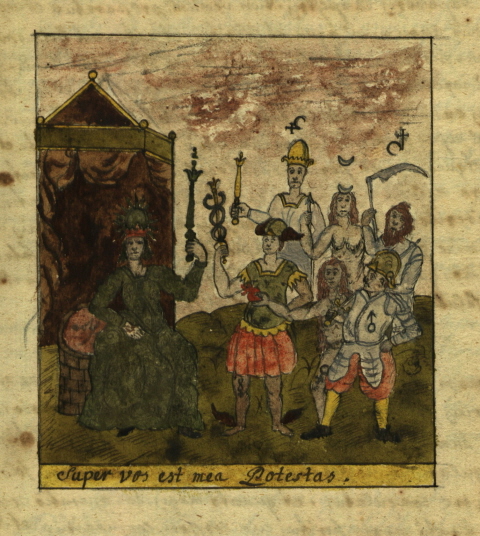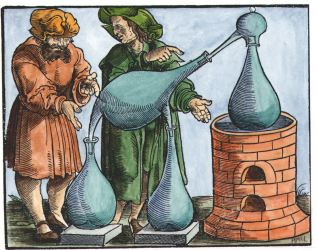| Author | Post |
|---|
Paul Ferguson
Member

| Joined: | Fri Feb 15th, 2008 |
| Location: | |
| Posts: | 1538 |
| Status: |
Offline
|
|
Posted: Tue Dec 23rd, 2008 09:55 pm |
|
I am currently translating Bonacina's "Compendiolum" of 1616, which is about Potable Gold.
I wonder if anyone can tell me what the abbreviation TP stands for in the illustration below, which occurs about halfway through the book.
I am sure the answer is obvious 
TIAAttached Image (viewed 1374 times):

|
adammclean
Member

| Joined: | Fri Sep 14th, 2007 |
| Location: | United Kingdom |
| Posts: | 606 |
| Status: |
Offline
|
|
Posted: Wed Dec 24th, 2008 10:38 am |
|
It could be 'Tria Principia', the three Paracelsian principles, Salt, Sulphur and Mercury.
|
Paul Ferguson
Member

| Joined: | Fri Feb 15th, 2008 |
| Location: | |
| Posts: | 1538 |
| Status: |
Offline
|
|
Posted: Wed Dec 24th, 2008 12:10 pm |
|
| Thanks Adam. This certainly seems possible. But could TP stand for 'Theophrasti Paracelsi'?
|
adammclean
Member

| Joined: | Fri Sep 14th, 2007 |
| Location: | United Kingdom |
| Posts: | 606 |
| Status: |
Offline
|
|
Posted: Wed Dec 24th, 2008 12:41 pm |
|
It could also be 'Theophrastus Paracelsus".
I was considering the fact that it stood above, and presumably referred to the three spheres with the shield in the nimbus of light. Perhaps if you can find some section of text which comments upon this, it might give a clear guide to the meaning.
|
Paul Ferguson
Member

| Joined: | Fri Feb 15th, 2008 |
| Location: | |
| Posts: | 1538 |
| Status: |
Offline
|
|
Posted: Wed Dec 24th, 2008 01:34 pm |
|
It is the prefatory illustration to Chapter IV of Part 2. This chapter is quite short and is reproduced below:
"Accedendo ad Praxim cum Arnaldo dicam: Actus activorum in patientis sunt dispositione: per quod intelligitur: Elixir fieri non posse, nisi ex materia, ad hoc perfectam dispositionem habente. Unde idem Arnaldus ait: Testificor autem vobis, ejusmodi habilitatem inesse matrici, ex qua manibus meis, oculis testibus, factum fuit Elixir: Saturnum convertens in solem; hanc eandem materiam jam vobis nominatam accipere debetis, et illam includere et regere, sicuti superius monstratum est, quod si bene et recte processeritis, sexta die post impositionem operis terna Capita Corvi apparebunt, signum quod opifex recte procedit, et verum regimen ignis invenit, unde speculum Alchymiæ in hunc finem scribit: Charissime fili, cum fueris in opere, fac, ut primo colorem nigrum habeas, et tunc eris certus, quod putrefactis, et rectam viam procedis. Item Hermes loquitur: Prima operatio est putrefactio, ideo oportet ipsum denigrare. Nunquam fuit animatum aliquid, aut nativitate creatum, neque crescens, nisi post corruptionem, et ejus mutationem: et habemus exemplum in ovo, quod primo putrescit, et tunc gignitur Pullus: qui post totum corruptum fit animal volans. Et Laurentius Ventura ait: Lapidis in præparatione est absolute putrefactionis signum, non qualiscunque, sed cum odore fetido, et omnino intolerabili: solutio et putrefactio cum odore fetido incipit, et continue crescit usque ad summum. Iste autem odor magis intellectu, quam sensu percipitur, quia qualis sit in opere, experimento didicimus ante opus. In opere cavendum est summopere, ne odor ejus sentiatur, alias opus destrueretur. Hac illa notate verba, et signate Mysteria. O Aquilina forma Pontica, quæ Elementa dissolvis! O Natura maxima naturarum Creatrix, quæ Naturam continet, et tenebrosam nebulam parit, quæ omnium est mater!"
|
adammclean
Member

| Joined: | Fri Sep 14th, 2007 |
| Location: | United Kingdom |
| Posts: | 606 |
| Status: |
Offline
|
|
Posted: Wed Dec 24th, 2008 01:47 pm |
|
None of these quotations from the authors seems to directly refer to the image.
Perhaps there is only a tangential association in this manuscript between the text and the imagery.
I suppose you will discover how strong this link is when you proceed further and see if the text in any way comments on the images.
|
Paul Ferguson
Member

| Joined: | Fri Feb 15th, 2008 |
| Location: | |
| Posts: | 1538 |
| Status: |
Offline
|
|
Posted: Wed Dec 24th, 2008 02:48 pm |
|
adammclean wrote:
None of these quotations from the authors seems to directly refer to the image.
Perhaps there is only a tangential association in this manuscript between the text and the imagery.
I suppose you will discover how strong this link is when you proceed further and see if the text in any way comments on the images.
Looking through, there are 11 images including the one in the frontispiece. Of these 3 carry legends relating directly to the following text, 3 have legends relating to text in other parts of the book, and 5 have legends with no apparent connection at all to the text.
Here are two more of these crudely drawn but charming images. I would be interested in hearing any observations on their style and content.
Here is "Death shall not prevail over me".Attached Image (viewed 1267 times):
 Last edited on Wed Dec 24th, 2008 03:39 pm by Paul Ferguson
|
Paul Ferguson
Member

| Joined: | Fri Feb 15th, 2008 |
| Location: | |
| Posts: | 1538 |
| Status: |
Offline
|
|
Posted: Wed Dec 24th, 2008 02:48 pm |
|
| And here's the other, "My power is above you". Attached Image (viewed 1259 times):
 Last edited on Wed Dec 24th, 2008 03:40 pm by Paul Ferguson
|
adammclean
Member

| Joined: | Fri Sep 14th, 2007 |
| Location: | United Kingdom |
| Posts: | 606 |
| Status: |
Offline
|
|
Posted: Wed Dec 24th, 2008 03:49 pm |
|
The White Queen (she sits on a throne seemingly labelled 'weis') receives the supplications of five of the other planets (these do not include the Sun). In the Donum Dei series, for example, this is emblematic of the White Tincture. The Red King in the next emblem (sitting on a throne, which appears to be labelled 'rot'), receives the six planets (including the Moon). He is emblematic of the Red Tincture. These are quite conventional images.
|
Tom Willard
Member

| Joined: | Mon May 5th, 2008 |
| Location: | Tucson, Arizona USA |
| Posts: | 96 |
| Status: |
Offline
|
|
Posted: Wed Dec 24th, 2008 08:58 pm |
|
| Wild guess, Paul. Treasure of the philosophers? Thesaurum philosophorum.
|
Paul Ferguson
Member

| Joined: | Fri Feb 15th, 2008 |
| Location: | |
| Posts: | 1538 |
| Status: |
Offline
|
|
Posted: Thu Dec 25th, 2008 10:22 am |
|
Tom Willard wrote:
Wild guess, Paul. Treasure of the philosophers? Thesaurum philosophorum.
First of all let me wish you the Compliments of the Season Tom, as well as everyone else using or visiting this forum!
This is certainly a possibility.
The author also quotes repeatedly from the Turba Philosophorum. I wonder if the symbol was taken from there?
|
Tom Willard
Member

| Joined: | Mon May 5th, 2008 |
| Location: | Tucson, Arizona USA |
| Posts: | 96 |
| Status: |
Offline
|
|
Posted: Fri Dec 26th, 2008 07:01 am |
|
Thank you for the good wishes of the season, Paul, which I reciprocate and extend to all members of this forum and especially our organizer, Adam.
You raise an interesting possibility when you say that your manuscript quotes extensively from the "Turba Philosophorum."
I was thinking of the phrase "thesaurus philosophorum" as used by Paracelsians--for example in the "Aurora Thesaurusque Philosophorum" prepared by Gerard Dorn in 1577.
But if your text quotes frequently from the "Turba," the T.P. could easily point back to a manuscript illustration. There is also a philosopher in the crowd called "Thebed." (Perhaps he is a Theban.) The index in vol. 5 of the "Theatrum Chemicum" refers to him as "Thebed Philosophus" and cites the opening pages of books 1 and 3.
Then again, the reference may be to a collection called the "Thesaurus Philosophiae." The "Rosarium" quotes "Ex thesauro philosophiae" at sig. E3v-4r (pp. 38-39 in Joachim Telle's edition of 1992). Telle identifies this work as "Eine spätmittelarterliche Sammlung von Dikta namentlich genanter Autoritäten, die sich in manchen Überlieferungen mit dem Namen eines nicht näher bekannten Frater Ferrarius verbindet und seit dem 16. Jahrhundert gedruckt worden ist" (2: 246).
|
Paul Ferguson
Member

| Joined: | Fri Feb 15th, 2008 |
| Location: | |
| Posts: | 1538 |
| Status: |
Offline
|
|
Posted: Fri Dec 26th, 2008 10:39 am |
|
Tom Willard wrote:
But if your text quotes frequently from the "Turba," the T.P. could easily point back to a manuscript illustration. There is also a philosopher in the crowd called "Thebed." (Perhaps he is a Theban.) The index in vol. 5 of the "Theatrum Chemicum" refers to him as "Thebed Philosophus" and cites the opening pages of books 1 and 3.
Bonacina also quotes from "Joannes Thebaidus", who is otherwise unknown to me.
|
Paul Ferguson
Member

| Joined: | Fri Feb 15th, 2008 |
| Location: | |
| Posts: | 1538 |
| Status: |
Offline
|
|
Posted: Fri Dec 26th, 2008 01:54 pm |
|
Here is a complete list of authors cited by Bonacina in his Compendiolum:
Admion (contributor to the Turba Philosophorum)
Aloisius Marlianus
Anon.
Aristæus (contributor to the Rosarium Philosophorum)
Aristotle
Arnaldus de Villa Nova
Avicenna
Basil Valentine
Bernard Trevisan
“Clangor Buccinae”, Authors of the
Cœlius
Cornelius Agrippa
Daniel Justinopolitanus
Flamel
Galen
Geber
Hermes
Hortulanus (contributor to the Rosarium Philosophorum)
Joannes Augustinus Augurellus
Joannes Chrysippus Fanianus
Joannes Fernelius
Joannes de Padua
Joannes Pontanus
Joannes de Rupecissa
Joannes Thebaidus
Laurentius Ventura
Lilius
Malcamech (contributor to the Rosarium Philosophorum)
Maurienus (mistake for Morienus?)
Merlinus
Metrix (???)
Mireris (same as Senior?)
Morienus
Paracelsus
Parmenides
Paulus Ægineta
Petrus Ramus
Plato
Pliny
Rasis (al-Razi)
Raymond Llull
Roger Bacon
Saturnus (“Philosophus Saturnus”)
Senior (same as Mireris?)
Simplicius
Theophilus (contributor to the Turba Philosophorum)
Theophrastus Graecus
Thomas Aquinas
Vergil
ZachariasLast edited on Sat Dec 27th, 2008 09:18 am by Paul Ferguson
|
Tom Willard
Member

| Joined: | Mon May 5th, 2008 |
| Location: | Tucson, Arizona USA |
| Posts: | 96 |
| Status: |
Offline
|
|
Posted: Fri Dec 26th, 2008 03:47 pm |
|
Looks like the name should be "Joannes Theobaldus." There was a Basel cleric of that name in the late sixteenth century:
http://aulongdudoubs.ifrance.com/uni-fribourg-mayer.htm
|

Current time is 09:33 am | Page: 1 2 3   |
|

